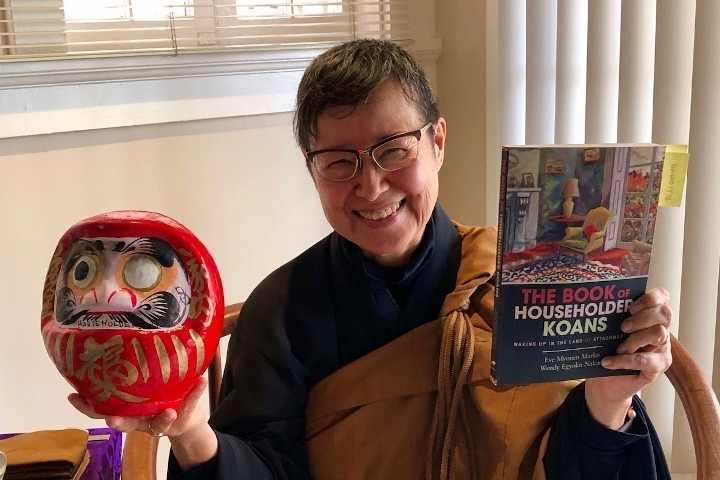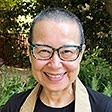
Musings on the Entangled Life
October 1, 2021
 by Wendy Egyoku Nakao
by Wendy Egyoku Nakao
The Avatamsaka Sutra says, “Now I see all living beings everywhere, and I see that each of them possesses the wisdom and virtue of Tathagata. But because of their delusions and attachments, they cannot realize it.” —Book of Equanimity, Case 67
The first line—all living beings everywhere…possesses the wisdom and virtue of Tathagata—asserts the foundation of awakening. The koan itself is excerpted from the Avatamsaka Sutra, the “Flower Garland Sutra,” which is a compilation—a stringing together into a garland—of Buddhist Sutras from around the 5th Century BCE in China. It is the primary sutra of the HuaYan (Flower Garland) School of Buddhism, developed by scholar-practitioners in China. The English language version of the Sutra by the prolific translator Thomas Cleary numbers 1,656 pages. I have read that Cleary, who recently passed away, read the entire Sutra in Chinese all the way through four times before he began to translate it. Reading this Sutra even once is a daunting undertaking.
The word “sutra” means “thread,” that which stitches together the relationships of life forms. These days we have all been living the “Pandemic Sutra,” which, with its imposed restraints, has opened us to the complex relationships of interbeing. We are experiencing many losses: of people dying from covid or from non-covid illnesses, of workplaces in upheaval, of social isolation, of housing disruption, and of communal disarray. We are discovering new insights about ourselves and those we thought we knew; sometimes the revelations have been uplifting; other times shocking and dismaying. And we are having a deeper understanding and direct experience of the complex and entangled nature of life itself. It is this “entangled nature” that is highlighted by both the “Pandemic Sutra” and the Avatamsaka Sutra— the complex and intricate web of relationships from which we cannot separate. Indeed, all is one undivided whole.
One of the key teachings in the Avatamsaka Sutra is that of Indra’s Net. The Vedic god Indra had a net with a jewel in each node that reflects every other jewel: the jewels, net strands, and the micro and macro reflections extend into infinity. This metaphor has come to symbolize the core wisdoms of Shakyamuni Buddha’s awakening, particularly that of emptiness, interconnection, and dependent co-arising. Roshi Bernie was fond of saying, “in Buddhism we have Indras’s Net; today we have the Internet.” Biologists, particularly those studying mycorrhizal relationships, now say we also have variations of a “wood wide web.” It seems that, little by little, we humans are waking up to what the Buddha realized, namely that “I, the great earth, and all beings are the wisdom and virtue of the Tathagata” —a declaration of the vast web of entangling connections among all living beings. The Buddha’s awakening exclamation does not prioritize a human-centered focus on life. Rather, the focus is all-centered; all-living-beings centered.
Awakening is a radical reorienting to the Oneness of life: to the web, the net, to the fact that all living beings everywhere are one living body. The vastness is dizzying for the limited minds in which we are trapped. Awakening blows open the limited thinking mind. What is so striking about this is that awakening thrusts us beyond the human-cen- tered story to which we are conditioned. Awakening is not a “me, myself, mine” story. This is not a story of nouns living with other nouns or one noun being more important than another. It is not the story of subjects and objects.
Siddhartha further exclaimed: “All Beings are Awake!” Or, we could interpolate that “All beings are alive!”—everything is living, verbing and vibing in an infinitely entangling web. Interestingly, the Latin root of the word “individual” means “indivisible.” Life is dynamically connecting in all directions; never static, but because of [your] delusions and attachments, [you] cannot realize it. Humans see themselves as separate in a world of subjects and objects. “Awakening” occurs when the Buddha eye opens to the web. “Living awake” is about constantly creating new ways to live within and alongside all beings in the web. We become porous and malleable and can consider a seagull-centered perspective, a tree-centered perspective, an earth-centered perspective, a homeless person-centered perspective, a Japanese-American perspective, a One-body perspective, and so forth. We start attuning to the needs of different living beings from their own perspectives within the perspectives of the One Body.
The Pali word “Tathagata” means “Thus come one,” or “Thus gone one,” or “One who is beyond coming and going.” Shakyamuni Buddha often used the word to refer to himself and to other Buddhas. In this instance upon awakening, the Buddha declared that all living beings everywhere—every person and every living “thing”—already has the wisdom and virtue of the Tathagata Buddha. By definition (according to sciencea-z.com), to be considered a “living being,” a being “must grow and develop, use energy, reproduce, be made of cells, respond to its environment, and adapt.” Don’t let your thinking mind get in the way of seeing that not just human beings are living beings, but the trees, starfish, fungi, birds, mycelium, mountains, bugs, soil, dust motes, and so forth! Each living being is a unique net node in which everything else is reflected. We are co-arising together always, a net of active forces that cannot be seen in isolation from even the smallest particle or the largest space. Among living beings, there is no “it;” there is no “thing”—there is no “object.” We, who are nouns as well as verbs, need to create new words that capture the dynamic life force with which all living beings are endowed.
The biologist and author Robin Wall Kimmerer, in her book Braiding Sweetgrass , speaks of this dynamic life force as captured by the indigenous Potawatomi language of her tribe. The English language is inherently noun oriented and dualistic. The Potawatomi language is abundant in verbs that extend living energies beyond human life. For example, the word for “hill” is a verb: to be a hill. For “bay:” to be a bay. For “Saturday:” to be a Saturday.
So a hill is always “hilling;” a bay is “baying;” a Saturday is “Saturdaying”. When we use a grammar of animacy, we no longer reduce the so-called inanimate or non-human to an “it” or a “thing” or an “object.” Reflect on this!
So what is the wisdom and virtue of the Tathagata? Let’s consider that this wisdom and virtue is the connective tissue of the One Body—it’s what makes our relationships come alive! It’s what enables Thus to become “Thus-ing.” In Zen practice, we learn that practice is a living question, not a question which seeks an answer. You don’t need to seek an answer because you are told the answer from the beginning of practice: all living beings everywhere … possess the wisdom and virtue of Tathagata. That is the answer; the question is: How am I living such a life?
What is the living question for you personally? Perhaps it is this: What if this person [name anyone], this being [name any being], this moment [whatever is happening] is the wisdom and virtue of the Tathagata Buddha? How is this re-orienting me? Or perhaps it is this: How am I myself living this moment as the connective tissue of the wisdom and virtue of the Tathagata? Raise these not as abstract questions, but as the living moment.
Whether you are reading these words—the wisdom and virtue of the Tathagata Buddha—for the first time or have read it many times or have heard it for many decades, as I have, I encourage you to sit down in it anew. See it new with the eyes, hear it new with the ears, taste it new with the tongue, wear it new with the body, and absorb it new with the mind. When filtered through delusions and attachments, to be “new” is nearly impossible, and yet, the sparks that arise from this declaration never grow mundane. (Let the spark burn a hole in limited mind!) A sheer sense of alive-ing, of discovering something out of one’s usual conditioned perceptions, arises as if for the first time. Each moment is a first-time momenting. Is it ever otherwise? The mind is adept at creating a before and after, a good and bad, and so forth. All of this is useful when it is useful, but underlying all is this “new-ing”—this wisdom and virtue of the Tathagata, the Thus-ing.
We are all powered by the wisdom and virtue of the Tathagata. I like the phrase “powered by” because the life forms that arise from the “zero” are simply astounding. The innumerable amount and diversity of life forms means that most are unseen and unknown. Because we are using words and concepts to describe experiences, we use words such as “oneness,” “interdependent,” “boundless,” and even “wisdom and virtue” or “Thusness,” but all such words do not ever come close to the dynamic, vivid life-ing itself.
Shakyamuni Buddha said, “… But because of their delu- sions and attachments, they cannot realize it.” We humans are thinking and decision-making beings. This is an extraordi- nary capacity. And yet, we must see through the thinking mind and the ways that we are immersed in it. Most living beings lack the thinking and decision-making capacity that we are so blessed with, and yet non-human living beings are also extraordinary. It is very difficult to talk about non-human beings without anthropomorphizing them—it requires an intense awareness on our parts to not interpret non-human life from our human-centered perspectives.
What we do with what arises—our attachments and delusions—is how the conundrums of our life arise. Our capacity to arrange and rearrange our biases is endless. Even our perceptions are conditioned. So, anchor yourself in the wisdom and virtue of Tathagata with which you and all living beings are endowed. We are entangled in this vast, mysterious life all together. You are reflecting the net and responding to it endlessly; the nodes of the net are reflecting and responding to you endlessly, too. The trees, the grass, the birds—all living beings around you, are responding to you. Do you notice this? Don’t get in the way!
Roshi Egyoku is ZCLA’s Head Teacher and Head Priest.
